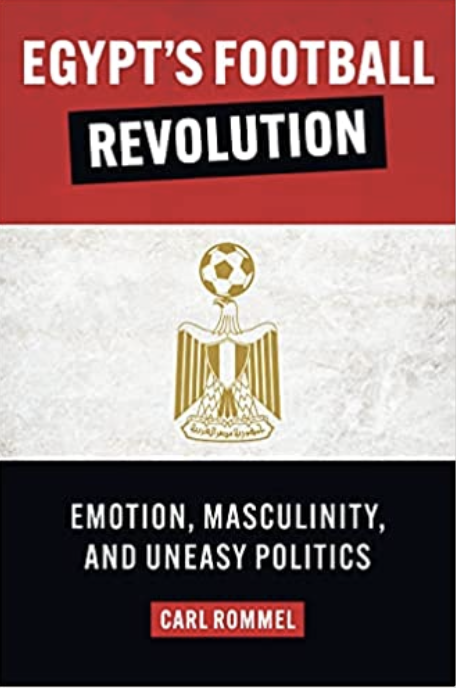Keywords: Politics, Revolution, Egypt, Emotions, Masculinity
In Egypt’s football revolution: Emotion, Masculinity, and Uneasy Politics, Carl Rommel lays out the recent history and rapid changes to the world of football in Egypt. Through detailed analysis of media, sports fans and revolutionary change, the reader follows the trajectory of the ‘national game’ from its peak of popular attraction to its fall into obscurity. With a focus on affect and emotions, this tale of football in Egypt is also one that tells of how the masculine national subject is supposed to feel, act and react to events that bring people, places, old and new media together like no other.
The unmistakable peak of football’s popularity in Egypt came about in the late Mubarak-era. Rommel describes how a new professional system around football, largely based on public funding, was reported on through new media infrastructures and supported by pop cultural productions, a generation of talented football players and seemingly limitless footballing success, created a national ‘bubble’ of hope, joy, and celebratory victory in a time of deep neoliberal reforms and crony capitalism in an Egypt that was otherwise characterized by a stand-still, frustration, boredom and increasing labor migration to the Gulf. In an unforeseen frenzy, the Egyptian national team won three African Cup of Nations titles consecutively in the end of the 00’s while the biggest national football clubs, the Cairene al-Ahly and al-Zamalek claimed 5 out of 10 Continental Champions League titles in the same decade. Rommel carefully examines how the football players of this age were crafted into national heroes and role models for an entire nation that came together in the love of the game. Then president Hosni Mubarak and his sons made sure to attend the games and celebrate with the players, conflating an image of togetherness and nationalism that strengthened their claim to Egypt and Egyptians even as the nation went through broad-scale crises and collectively traumatic events.
Football as the ‘national game’ of Egypt is uncontested for several reasons according to Rommel. It is by far the most played game in the nation and by far the most watched and talked about, but its greatest potential is one of unifying the nation as such. The intense rivalry between the Cairene clubs did not carry on into national team games. The supporters attending and watching the games did so across club loyalties, class, ethnic, generational and other boundaries. Football was thus a national project, and invested in as such by the political regime.
While football is the main theme of Rommel’s monograph, its greatest analytical purchase is looking at politics (siyasa) through the lens of the national sport, or rather, the avoidance of seeming political (siyasi). At its most basic level, we learn that the concept of politics in the Egyptian context is associated with a certain kind of use of power, promoting self-interest, corruption, violence and partisanship that pins one part of society against another, a destabilizing act loathed by all. Successful and legitimate use of power on the other hand necessarily works on the part of everyone, a greater national interest and grants a kind of certainty and stability. As becomes evident in the first part of Rommel’s work, such a nationalism around football was successfully constructed in the late Mubarak years but came to an end as match results went the wrong way and violence in the aftermath of the play-off for the World Cup in 2009 started off a conversation in Egypt about the nature of football and fandom as something disrupting and prone to extremism (taꜤassub) and thus potentially political. By using such events as turning points, Rommel manages to show how the unexpected is an integral part of the political and emotional in Egypt that also meant the national football bubble always had the potential to burst the way it did.
In the second part of the monograph we follow the struggles of the Ultras, dedicated fan groups, of Cairene al-Ahly and al-Zamalek in their relatively short-lived fame and national prowess. In a skillful and engaging manner, Rommel portrays the Ultras’ balancing act on the fine line between politics and nationalism as they engage in critique of the security state while carving out a space at their football stadiums for fun and enjoyment. As the 2011 revolution threw most things on their head, so the role of the Ultras also changed. While being careful not to take sides in the revolution, as to not seem political, Ultras members were prominent on the streets early on in the revolution and gained national recognition after a massacre at a football stadium in Port Said after which the Ultras demanded justice for those who lost their lives, putting pressure on state institutions. However, while being the champions of the entire people at one point, the groups were later blamed for being partisan and violent and thus political and a threat to the national order.
As the reader follows the aftermath of these rapid changes in the third part of the monograph, Rommel expands on the politics of politics in Egypt and the wider implications of the avoidance of seeming political. The reader learns how football relates to revolution and the potential for political change in a broader sense. In line with other anthropologists who have theorized the Egyptian revolution, Rommel reaffirms the sense that it was not mainly ideological but rather physical and emotional in the same sense as politics (siyasa) itself is put forth throughout the text. The focus on individual interlocutors, events, and large-scale processes in an interwoven manner adds richness to the texture of this excellent piece that ought to spark interest among sports fans and academics alike.
© 2023 Victor Nygren
![]()

